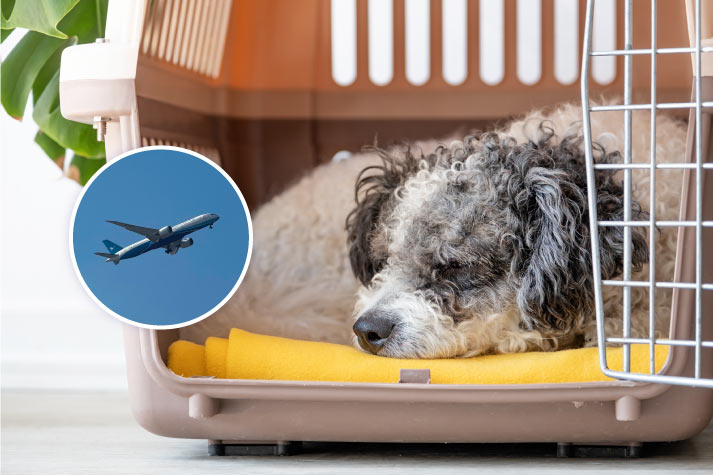
22 Oct
Expert Guide to Choosing and Preparing the Perfect Pet Travel Crate
When traveling with your pet, ensuring their safety and comfort is essential. One of the most important decisions you'll make is choosing the right travel crate, especially for air travel. Not only does the crate need to comply with airline regulations, but it should also provide enough space for your pet to feel at ease during the journey. Whether you’re traveling with a dog, cat, bird, or even an exotic pet, this guide will help you choose and prepare the perfect travel crate to ensure a smooth and safe trip.
Why the Right Pet Crate Matters?
The right pet crate plays a crucial role in ensuring your pet’s safety, well-being, and compliance with airline standards. Whether you’re flying internationally or domestically, your pet’s crate must meet certain size and meet the material and construction requirements. The crate should be large enough for your pet to stand, turn, and lie down comfortably. Crates that are too small can cause discomfort and increase stress levels during transit, which is not ideal at all for pet travel.
Additionally, airlines have specific regulations about crate construction and design. If the crate fails to meet these standards, it may not be accepted for transport, potentially delaying your travel plans. This makes it crucial to start planning and preparing your pet’s travel crate well in advance of your departure date.
How to Measure Your Pet for a Crate
Accurately measuring your pet is the first step in selecting the right crate. Here’s a simple method to ensure you choose a size that meets airline requirements while keeping your pet comfortable:
- Height: Measure from the top of your pet’s head to the floor while they are standing tall.
- Length: Measure from the tip of the nose to the base of the tail.
- Width: Measure the widest part of your pet’s body, usually the chest area.
Using these measurements, find a crate that offers your pet enough space to move around, lie down, and sit comfortably without hitting the roof of the crate. Here’s a quick checklist to ensure the crate is the right fit:
The crate allows your pet to stand comfortably without hunching or ducking, turn around, and lie down with their paws fully extended is acceptable and your pet can fly in such a crate. However, if your pet has to crouch to see out of the crate, cannot turn around, or struggles to lie down, the crate is too small.
Choosing the Right Crate
Once you’ve measured your pet, the next step is finding a crate that meets airline regulations. In the U.S., crates must comply with USDA (United States Department of Agriculture) and IATA (International Air Transport Association) standards. While each airline may have slightly different guidelines, most follow these general rules:
- Material: Crates should be made of hard plastic, metal, or wood. The top of the crate must be solid, with no ventilation or doors, to provide structural integrity.
- Doors: The crate door must be made of metal and should close securely. Plastic doors are not acceptable. Metal bolts and nuts must be used to connect the top and bottom parts of the crate.
- Ventilation: The crate should have adequate ventilation on all sides to allow fresh air to circulate. However, the top of the crate should remain solid to ensure stability.
- Water Dishes: There must be two water dishes attached to the inside of the door, allowing easy access for handlers to refill water without opening the crate. These dishes help keep your pet hydrated during long flights.
- Leak-Proof Floor: The bottom of the crate must be leak-proof, and it’s recommended to place absorbent material, such as a towel or shredded newspaper, at the base to manage any accidents.
- Material: Crates should be made of hard plastic, metal, or wood. The top of the crate must be solid, with no ventilation or doors, to provide structural integrity.
- Doors: The crate door must be made of metal and should close securely. Plastic doors are not acceptable. Metal bolts and nuts must be used to connect the top and bottom parts of the crate.
- Ventilation: The crate should have adequate ventilation on all sides to allow fresh air to circulate. However, the top of the crate should remain solid to ensure stability.
- Water Dishes: There must be two water dishes attached to the inside of the door, allowing easy access for handlers to refill water without opening the crate. These dishes help keep your pet hydrated during long flights.
- Leak-Proof Floor: The bottom of the crate must be leak-proof, and it’s recommended to place absorbent material, such as a towel or shredded newspaper, at the base to manage any accidents.
For larger dogs that exceed standard crate sizes, custom-made crates adhering to IATA guidelines may be necessary. These custom crates can ensure your pet’s safety but may require additional coordination with the airline, as they might not fit in all aircraft cargo holds.
Preparing Your Pet for Crate Travel
Crate training your pet ahead of the journey is essential for a stress-free travel experience. You should start by introducing the crate as a positive space ahead of time, weeks or even months before your travel date. Let your pet interact with it on their own before slowly getting them accustomed to it.
Here are a few steps to help:
- Familiarization: Place the crate in a common area and allow your pet to explore it. Encourage them to enter the crate by placing treats or toys inside.
- Short Stays: Gradually increase the amount of time your pet spends in the crate. Start with short periods and work up to longer durations, ensuring your pet feels comfortable and secure.
- Calm Environment: Keep the training experience positive. Never force your pet into the crate or use it as punishment, as this can create a negative association.
- Practice Travel: Take your pet on short car rides in the crate to simulate the travel experience. This will help them get used to the motion and sounds of transport.
By the time travel day arrives, your pet should feel at ease in their crate, reducing anxiety during the journey.
Special Considerations for Exotic Pets
If you’re traveling with an exotic pet like a bird, reptile, or small mammal, you may need a specially designed crate. Birds require cages with secure perches and food dishes, while reptiles need temperature control. It’s essential to consult with a veterinarian or a pet relocation specialist to ensure your exotic pet’s crate is suited to their unique needs.
To conclude, choosing the right travel crate is crucial for a successful and safe journey with your pet. By ensuring the crate meets airline standards, provides adequate space, and familiarizing your pet with the crate ahead of time, you can make the travel experience much smoother for both you and your furry friend. Always double-check airline-specific guidelines and consult with a pet relocation expert if necessary. With the right preparation, your pet’s travel experience can be a comfortable and stress-free adventure.






AUTHOR’S BIO
Carry My Pet
Passionate pet enthusiasts and globetrotters, dedicated to easing furry friends' journeys worldwide. Penning tales of compassion at CarryMyPet, where every relocation is a tail-wagging adventure.